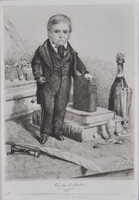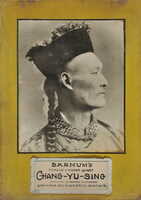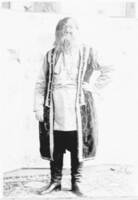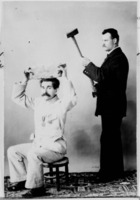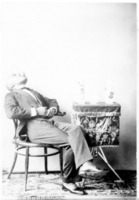Performers
General Tom Thumb : Charles S. Stratton
Charles Stratton, professionally known as General Tom Thumb was one of the most famous performers of the Victorian period. A distant relative of P.T. Barnum, Stratton was touring with Barnum by the age of five in 1844. Stratton never grew past 3.25 ft and had a talent for impersonations, singing, and dancing. His tours in Europe and America made him an international celebrity and by the 1860s had made Barnum and Stratton very wealthy. Stratton would go on to marry a fellow little person and their marriage was front page news (Crockett, 2014).
The Bearded Lady : Annie Jones
Annie Jones's circus career started at the age of only nine months at P.T. Barnum's exhibit. She was billed as the "Infant Esau." Esau being Jacob's famously hairy brother in the Old Testament. She was such a popular attraction her parents were paid $150 a week for her performances. Her popularity did not diminish as she grew older, and neither did her hair growth. Although it is unknown what exactly caused Annie's abnormal hair growth, she reportedly had a full beard and sideburns by the age of five. She became incredibly well known as a bearded lady during the Victorian Age. Her performance included playing instruments and dressing in very fashionable dresses to provide for the contrast the beard. Jones married twice, once to Richard Elliot, who she divorced after 15 years, and second to William Donovan. After marrying Donovan, the couple opted to tour as a duo act and traveled Europe. However, Donovan died four years after the marriage and Jones returned to P.T. Barnum's exhibit. She began campaigning against the use of the word "freak" to describe performers such as herself and her coworkers. Unfortunately she died of tuberculosis in 1902, two years after she returned, before she could achieve much with her campaign (Dimuro, 2018).
Siamese Twins : Chang and Eng Bender
Chang and Eng were born congenitally joined at the waist in 1811 in Siam. They were famous even as children and were eventually sponsored by a British merchant in 1829 and toured the U.S., Canada, and Europe on exhibit. After the age of 21, Chang and Eng took charge of their own tours and therefore no longer gave up most of their earnings to their sponsor and they soon became very wealthy. They eventually settled on a farm in North Carolina and became naturalized American citizens. Chang and Eng both married and since they maintained separate households they alternated three-day visits with their respective spouses and in total fathered 21 children. Out of necessity Chang and Eng went on tour once more in 1869 after losing most of their money in the Civil War. In 1874, Chang died during the night with Eng following three hours later (Ray, 2020).
Lionel the Lion-Man : Stephan Bibrowski
Stephan Bibrowski was professionally known as "Lionel the Lion-Man." There are conflicting reports on much of his early life. He was born in Poland about 1890 and most likely suffered from hypertrichosis, which causes hair growth in abnormal areas of the body. In Stephan's case, his blond hair reportedly covered his body and grew up to four inches long , except on his face where it reached eight inches. By the age of four he was 'discovered' by the circus and a German showman, Herr Sedlmeyer began touring Bibrowski across Europe. It known that Bibrowksi received an education whilst under the care of Sedlmeyer as he could speak a reported five languages. They both traveled to America in 1901 and Bibrowski began performing at the Barnum & Bailey Circus in 1902 where he performed acrobatics and conversed with the audience. Bibrowski traveled with the Barnum & Bailey circus until 1920 when he settled in the United States for a time and began performing at Coney Island. In his conversations with his audiences, Bibrowski was revealed to be a gentle and intelligent man who had aspirations to be a dentist. Bibrowski eventually returned to Germany in the late 1920s where he died of natural causes in 1932 (Serena, 2020).
Chang the Chinese Giant : Chang Woo Gow (Zhan Shichai,詹世釵)
Chang Yu Sing was born Chang Woo Gow (Zhan Shichai, 詹世釵).Chang’s early life is unknown as is his exact date and place of birth. Chang was born sometime in the 1840’s either in Peking, modern Beijing, or Fuzhou, China. Chang was touted as the “Tallest Man in the World” at an almost 8 feet tall. He first appeared in the West in an exhibition at the Egyptian Hall in Piccadilly, England with his wife Kin Foo and a Chinese little person named Chung Mow in 1865. Chang and his wife toured Europe, America and in the 1870s, Australia and New Zealand. Kin Foo would converse in English with the audience before Chang came out to perform and sell souvenir photographs of the troupe. Half of Chang’s earnings from his performance at the Benevolent Asylum in Bendigo in 1871 were donated back to the Asylum. Kin Foo died in the 1870’s while touring in Australia. After her death, Chang married an English woman Catherine Santley and they had two children together. The family moved to England in 1880, however Chang went on tour for P.T Barnum that year in America. Barnum reportedly lured him to America by offering to pay him $500 a month. For the tour he posed as a Mongolian warrior, a French soldier, and in mandarin robes. Chang soon returned to his family and by 1891 they were living in Bournemouth, England. It is likely they moved there to help with Chang’s tuberculosis. In Bournemouth Chang ran a Chinese tea and curio shop. He was reported to have died of a broken heart four months after his wife died (Couchman, 2003).
Jojo the Human Skye Terrier : Fedor Jeftichew
Before America met Stephan Bibrowski, they had Fedor Jeftichew, known professionally as "Jojo the Human Skye Terrier" or "The Dog Boy." Jeftichew was born in St.Petersburg, Russia in 1868 and, along with his father, had the condition known as hypertrichosis, which causes excessive hair growth. In his youth, Jeftichew traveled with his father performing as a father and son duo in Russia and France. However, when he was 16 and his father died, P.T Barnum offered Jeftichew a place in his travelling circus. Jeftichew accepted and toured in Barnum's circus until 1900. Barnum created a new backstory for his act to attract audiences in which Jeftichew and his father lived in a cave and were captured by a Russian hunter, and though they worked in the city, neither could be tamed or civilized. During his performances Jeftichew wore a Russian calvary uniform to contrast with his perceived animalistic looks and occasionally barked or growled on demand. Normally, though, he was seen as gentle and dignified, allowing members of the audience to approach and tug on his hair to verify his appearance. Jeftichew was one of Barnum's highest paid performers, earning $500 a week in 1886. Additionally, he, along with other performers protested the use of the work "freak" as a description in 1898 and won the right to use the title "prodigies". After leaving Barnum's circus Jeftichew toured the world but passed away in Greece after contracting pneumonia in 1904 (Yadav, 2018).
